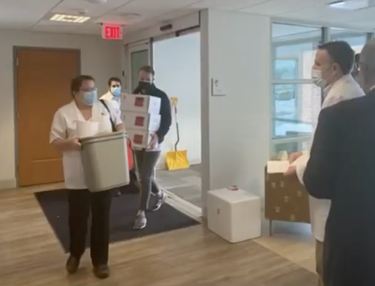Nursing home workers and residents start getting COVID-19 shots on Monday
ALBANY COUNTY — On Monday, COVID-19 vaccinations were given at nursing homes locally and across the state.
At the same time, both the governor and the county executive spoke of the need to educate people who refuse to get the shot, particularly to get Black and brown communities to participate. A state task force has been named to oversee equitable distribution of the vaccine.
Of the roughly 172 current residents of Shaker Place, Albany County’s nursing home, 150 have agreed to take the shots, Daniel McCoy, the county’s executive, said at his Monday morning press briefing.
The other 22 either don’t want the shots or need a health-care proxy to sign off for them, and some of those people making the decisions for the residents have not yet been reached, McCoy said.
Of Shaker Place’s roughly 200 workers, only 100 have agreed to be vaccinated, McCoy said.
“We have to educate our own workers …,” he said. “We have to get everyone to understand that this is the way we’re going to get out of it.”
About three-quarters of the general population will have to be vaccinated for restrictions to be lifted.
McCoy said he was surprised that half of the workers refused to be vaccinated and surmised they were worried about side effects. “That was more alarming to me than the 20 residents,” he said.
“I don’t want to mandate any vaccine to anyone who doesn’t want to take it … To force someone, no; I don’t think that’s a good play for government,” he said.
“I feel it’s an early Christmas present,” said McCoy of the shots being administered on Monday. The first doses, for both the residents and workers who have agreed, will have been administered by Wednesday, he said, and the process will take six weeks as two doses are required.
Any extra doses will be returned to Walgreens, which is administering the vaccine, to be used elsewhere, he said.
At the end of six weeks, McCoy said, he hopes visitors will be allowed at Shaker Place. “It’s long overdue,” he said.
McCoy said the nursing home may have to be divided into different sections to keep residents and workers who have refused the vaccinations separate from those who have been innoculated.
Asked if he would take a vaccination himself to serve as a model for others, McCoy said he was eligible as a member of the National Guard but thought the vaccine, in short supply, should go to essential workers first.
“I think it’s the wrong message,” he said of himself taking a shot although he added that Vice President Mike Pence taking a vaccine was “a good message to send” because so many Trump supporters believed the virus wasn’t a threat.
At his Tuesday morning video press conference, Governor Andrew Cuomo also said that the vaccination of nursing home residents and staff should take six weeks to complete.
“We have worked with the pharmacies and the federal government. CVS is going to do 271, Walgreens 253, other pharmacies 94. These are the 618 nursing homes that are enrolled in the program,” Cuomo said.
So far, 38,000 vaccine doses have been administered in New York State, Cuomo said.
He also said, “More vaccines are coming every day: 346,000 Moderna coming this week, 120,000 more Pfizer doses coming this week. We expect to have a total of 630,000 doses by this week. This week, we increase the priority populations that the hospitals will be allowed to administer — federally qualified health center workers, EMTs, coroners, medical examiners, funeral home workers, other congregate care workers and residents.”
Cuomo announced that a task force has been named to ensure equitable distribution of the vaccine. The Vaccine Equity Task Force is chaired by Secretary of State Rossana Rosado, Attorney General Letitia James, National Urban League President Marc Morial, and Healthfirst President Pat Wang.
“Key for me in this vaccination program is to make sure the vulnerable communities and underserved communities are not left behind,” Cuomo told reporters. “They were left behind during COVID, highest death rate, highest infection rate, lowest testing rate, Black communities, Latino communities, poor communities.
“Left to the market’s forces you will see once again Black, Latino and poor communities left behind. We’re doing everything we can to make sure that doesn’t happen and I want this state to be a model for the nation of equitable outreach when it comes to a vaccine.”
Cuomo said that New York is developing Community Vaccination Kits for health-care deserts, with the supplies and resources needed for standing up vaccination sites.
The kits are easily transportable. “You can send the shipping container right ... on the back of a truck, bring it to a public housing authority, to a church, to a community center, anywhere in the state. Everything you need. Computers, IT, medicines, wall dividers, tables, chairs, schematic for how you set up the space,” Cuomo said.
McCoy said that, when Albany County started its walk-up COVID testing program in high-risk neighborhoods, it was hard to get residents to participate. “We talked to pastors, Albany Housing, elected officials,” he said.
Often residents of health-care deserts don’t have doctors and aren’t aware they have underlying health conditions, said McCoy. The county is considering public-service commercials to reach people, he said.
“We have to get buy-in from the community,” McCoy said.
Similarly, Cuomo said, “There is a very real resistance to taking this vaccine, especially in the Black community. There’s a history that would give one a right to be skeptical. We need public education to combat that.”



